Chronic pulmonary LPS tolerance induces selective immunosuppression while maintaining the neutrophilic response
- PMID: 19487981
- PMCID: PMC3670960
- DOI: 10.1097/SHK.0b013e3181aa9690
Chronic pulmonary LPS tolerance induces selective immunosuppression while maintaining the neutrophilic response
Abstract
LPS challenge causes potent activation of innate immunity. Because LPS is ubiquitously present in ambient air, repeated inhalation may lead to activation of the pulmonary immune response. If this activation is unregulated, chronic LPS inhalation would lead to persistent inflammation and organ damage. We hypothesized that the lung uses the mechanism of LPS tolerance to maintain the balance between hypoinflammatory and hyperinflammatory states. We developed a model of chronic pulmonary LPS tolerance induced by pulmonary exposure to 1 microg LPS for 4 consecutive days. Mice were challenged with 10 microg of LPS 24 h later. TNF-alpha protein was significantly decreased in the bronchoalveolar lavage fluid of tolerant versus nontolerant mice, whereas IL-6 levels were significantly increased in the tolerant group. Tolerant mice were also protected from airway hyperresponsiveness. M2 and M3 muscarinic receptor mRNA was significantly decreased in the lungs of tolerant mice, suggesting a mechanism for the decreased airway hyperresponsiveness. CXCL2 was significantly reduced in tolerant mice, but CXCL1 was equivalent between groups. No difference was seen in neutrophil recruitment to the alveolar space. Interestingly, LPS tolerance does not confer cross-tolerance to the Toll-like receptor (TLR) 2 stimulus Pam3Cys. TNF-alpha and IL-6 concentrations were significantly increased in LPS-tolerant mice challenged with Pam3Cys; however, chemokine concentrations were unaffected. Our data show that repeated LPS inhalation results in differential regulation of cytokines but does not inhibit neutrophil recruitment. This unrestricted neutrophil recruitment may represent a mechanism by which individuals may be protected from pulmonary bacterial infection and pneumonia.
Figures


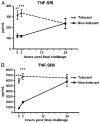
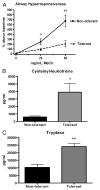
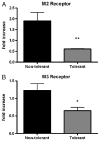
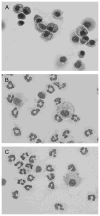
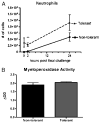


Similar articles
-
Reducing LPS content in cockroach allergens increases pulmonary cytokine production without increasing inflammation: a randomized laboratory study.BMC Pulm Med. 2011 Feb 23;11:12. doi: 10.1186/1471-2466-11-12. BMC Pulm Med. 2011. PMID: 21345191 Free PMC article.
-
Acute pulmonary lipopolysaccharide tolerance decreases TNF-alpha without reducing neutrophil recruitment.J Immunol. 2008 Dec 15;181(12):8402-8. doi: 10.4049/jimmunol.181.12.8402. J Immunol. 2008. PMID: 19050257 Free PMC article.
-
Differential effects of ebselen on neutrophil recruitment, chemokine, and inflammatory mediator expression in a rat model of lipopolysaccharide-induced pulmonary inflammation.J Immunol. 2002 Jul 15;169(2):974-82. doi: 10.4049/jimmunol.169.2.974. J Immunol. 2002. PMID: 12097404
-
Concomitant exposure to ovalbumin and endotoxin augments airway inflammation but not airway hyperresponsiveness in a murine model of asthma.PLoS One. 2014 Jun 26;9(6):e98648. doi: 10.1371/journal.pone.0098648. eCollection 2014. PLoS One. 2014. PMID: 24968337 Free PMC article.
-
Low intensity laser therapy (LILT) in vivo acts on the neutrophils recruitment and chemokines/cytokines levels in a model of acute pulmonary inflammation induced by aerosol of lipopolysaccharide from Escherichia coli in rat.J Photochem Photobiol B. 2010 Dec 2;101(3):271-8. doi: 10.1016/j.jphotobiol.2010.07.012. Epub 2010 Jul 27. J Photochem Photobiol B. 2010. PMID: 20728373
Cited by
-
The Ability of Respiratory Commensal Bacteria to Beneficially Modulate the Lung Innate Immune Response Is a Strain Dependent Characteristic.Microorganisms. 2020 May 13;8(5):727. doi: 10.3390/microorganisms8050727. Microorganisms. 2020. PMID: 32414154 Free PMC article.
-
Effects of Unilateral Vagotomy on LPS-Induced Aspiration Pneumonia in Mice.Dysphagia. 2023 Oct;38(5):1353-1362. doi: 10.1007/s00455-023-10564-3. Epub 2023 Feb 14. Dysphagia. 2023. PMID: 36788140
-
Endotoxin Tolerance Acquisition and Altered Hepatic Fatty Acid Profile in Aged Mice.Biology (Basel). 2023 Mar 31;12(4):530. doi: 10.3390/biology12040530. Biology (Basel). 2023. PMID: 37106731 Free PMC article.
-
Pulmonary endotoxin tolerance protects against cockroach allergen-induced asthma-like inflammation in a mouse model.Int Arch Allergy Immunol. 2012;158(2):120-30. doi: 10.1159/000330896. Epub 2012 Jan 24. Int Arch Allergy Immunol. 2012. PMID: 22269653 Free PMC article.
-
Reducing LPS content in cockroach allergens increases pulmonary cytokine production without increasing inflammation: a randomized laboratory study.BMC Pulm Med. 2011 Feb 23;11:12. doi: 10.1186/1471-2466-11-12. BMC Pulm Med. 2011. PMID: 21345191 Free PMC article.
References
-
- Miller SI, Ernst RK, Bader MW. LPS, TLR4 and infectious disease diversity. Nat Rev Microbiol. 2005;3(1):36–46. - PubMed
-
- Andonegui G, Goring K, Liu D, McCafferty DM, Winston BW. Characterization of S. Pneumoniae pneumonia–induced multiple organ dysfunction syndrome; an experimental mouse model of Gram-positive sepsis. Shock. 2009;31(4):423–428. - PubMed
-
- Dremsizov T, Clermont G, Kellum JA, Kalassian KG, Fine MJ, Angus DC. Severe sepsis in community-acquired pneumonia: when does it happen, and do systemic inflammatory response syndrome criteria help predict course? Chest. 2006;129(4):968–978. - PubMed
-
- Foster SL, Hargreaves DC, Medzhitov R. Gene-specific control of inflammation by TLR-induced chromatin modifications. Nature. 2007;447(7147):972–978. - PubMed
Publication types
MeSH terms
Substances
Grants and funding
LinkOut - more resources
Full Text Sources

